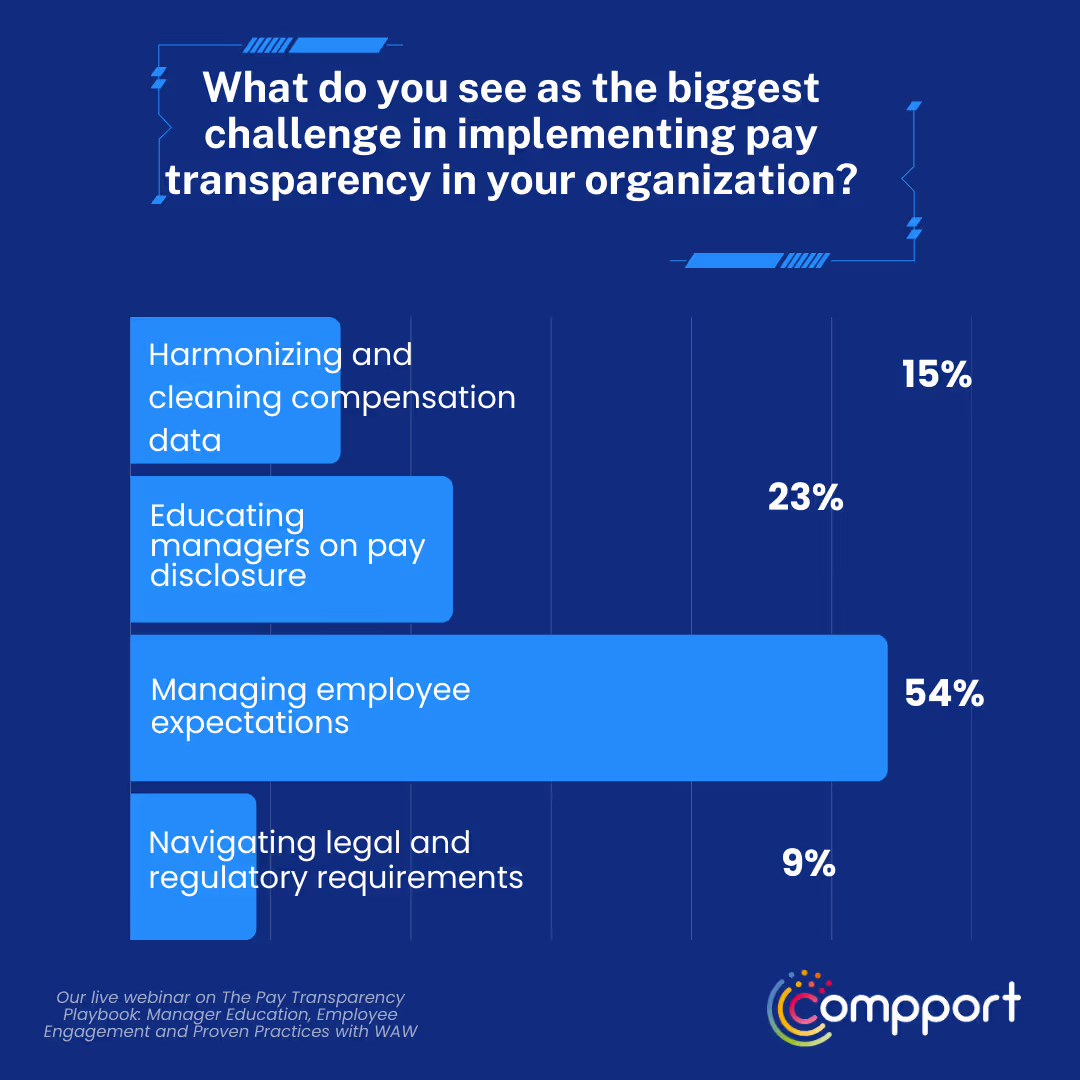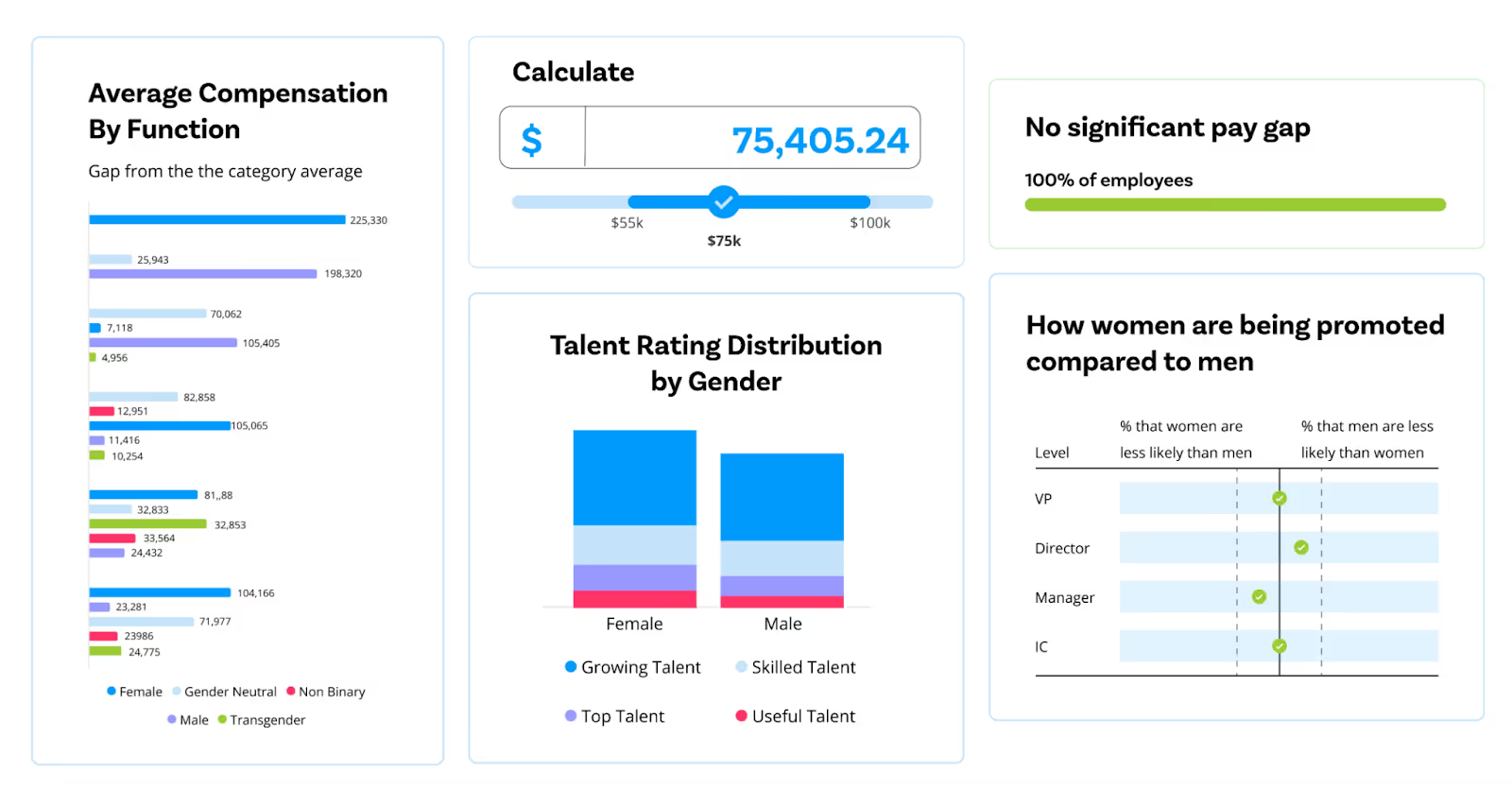What does Pay Transparency Mean? The Only Pay Transparency Handbook You Need
%20(9).avif)
Imagine Charlie, a talented software engineer, discovering that his colleague with similar experience earns 20% more for the same role. This scenario plays out daily across organizations, highlighting why pay transparency has become more than just a buzzword: it's a business imperative.
Yet surprisingly, only 19% of U.S. companies have a pay transparency strategy in place, according to Mercer's 2024 Global Survey. This disconnect between employee expectations and organizational readiness creates a critical workplace gap.
The solution isn't just posting salary ranges in job descriptions - it requires a fundamental shift in how organizations approach, communicate, and manage compensation.
This handbook will guide you through everything you need about pay transparency, from understanding its core principles to implementing practical strategies that work in an evolving workplace landscape.
What does Pay Transparency Mean?
Pay transparency means openly sharing how, why, and what an organization pays its employees. Think of it like a recipe book - instead of keeping compensation decisions behind closed doors, organizations share the ingredients (factors) and methods (processes) that determine pay.
This transparency can take different forms:
Basic transparency looks like posting a job for a Marketing Manager with a clear salary range of $85,000-105,000 rather than the vague "competitive salary" description.
Moderate transparency involves explaining to employees how their pay is determined. For example, telling John, a Senior Developer, that his $120,000 salary is based on his 7 years of experience, tech stack expertise, and market benchmarks for similar roles in his location.
Full transparency means organizations openly share:
- Salary ranges for all positions
- How pay decisions are made (like years of experience, skills, performance metrics)
- Information about bonus structures and benefits
- Company-wide compensation philosophy and practices
This level of openness helps ensure fairness, reduce bias, and build trust between employers and employees. It shifts compensation from a mysterious process to an open conversation based on clear, objective criteria.
A real-world example: Buffer

In 2024, Buffer introduced its "Open Salary System," moving beyond a simple formula to a comprehensive three-part framework: market data, Buffer benchmarks, and Buffer salaries.
Their system determines pay using level 5 market data (70th-90th percentile based on role) as a foundation, then applies consistent percentage increases between levels. Location affects salaries through two bands: high (100%) or global (90%). Buffer's transparency commitment has yielded significant results - with average employee tenure exceeding industry norms and 71% of employees receiving salary increases under the new system.
The company views transparency as essential for building trust and maintaining equitable compensation practices.
Why is Pay Transparency Important?
Understanding the importance of pay transparency requires looking through three distinct lenses - the employee seeking fairness and clarity, the employer building trust and talent attraction, and the HR professional designing equitable systems.
Each perspective brings unique insights into why transparency has evolved from a controversial concept to a business necessity. While employees focus on personal growth and fair treatment, employers consider organizational culture and competitive advantage, and HR bridges these viewpoints while ensuring compliance and structure.
These perspectives paint a complete picture of pay transparency's critical role in modern workplace dynamics.
Employee perspective
Pay transparency empowers employees with information crucial for their career decisions. When organizations share compensation data and practices openly, employees can:
- Understand their market value and whether they're fairly compensated
- Make informed decisions about career progression and skill development
- Feel more confident about pay equity within their organization
- Have clearer conversations about compensation with managers
- Trust their employer's commitment to fairness
Employer perspective
For organizations, pay transparency offers strategic advantages:
- Attracts higher-quality candidates who value openness and fairness
- Reduces time spent in salary negotiations during hiring
- Improves employee trust and engagement
- Decreases turnover by eliminating pay uncertainty
- Creates accountability for maintaining equitable pay practices
- Strengthens employer brand as a fair and transparent workplace
HR perspective
For HR professionals, pay transparency serves as a powerful tool for:
- Streamlining compensation management through standardized practices
- Reducing pay equity issues before they arise
- Creating more explicit frameworks for promotions and raises
- Supporting managers in having compensation conversations
- Meeting increasing regulatory requirements around pay disclosure
- Building stronger compensation strategies based on data
- Improving workforce planning and budgeting accuracy
This multi-stakeholder importance explains why pay transparency has evolved from a nice-to-have into a business imperative in today's workplace.
How is the Current Pay Transparency Ecosystem Globally?
Pay transparency laws are reshaping the global workplace, with each region taking its path toward salary disclosure requirements. In the United States, a mosaic of state laws shapes compliance requirements. California and New York lead with comprehensive legislation requiring salary ranges in job postings, while Colorado's pioneering law has become a model for other states.
As of 2025, one in three U.S. employees are covered by pay transparency laws, marking a significant shift in workplace practices.
The European Union is setting a new global standard with its Pay Transparency Directive, requiring all member states to implement comprehensive transparency measures by June 2026. This directive goes beyond salary disclosure, mandating equal pay reporting and banning salary history questions in interviews.
Brazil has emerged as a regional leader in Latin America, implementing strict pay equity requirements and maintaining detailed compensation records for larger employers. These global developments signal a clear trend toward greater transparency in compensation practices worldwide.
Key drivers of the pay transparency movement
Trust and fairness in compensation have moved from a "nice to have" to a business imperative. Three key forces accelerate this shift toward greater pay transparency across organizations worldwide.
Employee expectations
Today's workforce demands clarity around compensation. According to Mercer, 75% of employers acknowledge that candidates expect transparent pay practices. Modern employees seek organizations that openly share salary ranges and the complete picture of how pay decisions are made.
Competitive pressures
As companies compete for talent, transparency has become a differentiator. Organizations that maintain pay secrecy risk losing candidates to more open competitors. The rise of remote work has intensified this pressure, as employees can easily compare compensation across companies and locations.
Social and cultural shifts
Growing awareness of pay inequities, particularly around gender and race, has sparked demands for greater accountability. This cultural shift and generational changes in workforce attitudes about discussing pay have made transparency a key indicator of an organization's commitment to equity.
Challenges You Might Face when Establishing the Pay Transparency Function
In our recent webinar, we asked the attendees about their biggest challenge in implementing pay transparency in their organizations. A staggering 54% voted that managing employees’ expectations is their biggest challenge.

On that note, here are a few challenges that you might face if you are trying to establish the pay transparency function in your organization from scratch:
Infrastructure and data readiness: The foundation gap
Most organizations discover their systems aren't built for transparency. The challenge begins with fragmented data across payroll, HR, and performance platforms that don't integrate effectively. Legacy manual processes and spreadsheet-based compensation tracking make real-time transparency nearly impossible.
Maintaining accurate pay information becomes administratively overwhelming and risky without robust technology infrastructure. Companies need integrated compensation systems, standardized job architectures, and clear frameworks to implement transparency while maintaining data accuracy and trust.
Privacy vs. openness: Walking the tightrope
While transparency promotes fairness, organizations must carefully navigate privacy concerns. Some employees may feel uncomfortable publicly recognizing compensation, especially in smaller teams or markets. Companies must determine the appropriate level of detail to share – salary ranges, exact figures, or aggregated data. Finding this balance is crucial, as too much disclosure could create workplace tension, while too little undermines transparency goals.
Legacy pay gaps: Confronting historical inequities
When organizations become transparent about pay, existing disparities often come to light. These gaps might stem from historical hiring practices, market changes, or unconscious bias. Addressing these disparities requires significant budget allocation and careful communication planning. Companies must be prepared and keep budgets ready to explain gaps, create action plans for corrections, and maintain consistency in future hiring. Failure to address disparities proactively can lead to decreased morale and potential legal issues.
Employee engagement: Managing the transparency fallout
Transparency inevitably triggers questions and comparisons among employees. Some may discover they're paid less than colleagues or industry standards, leading to dissatisfaction and potential turnover. Organizations need to train managers to handle difficult compensation conversations, explain pay decisions clearly, and address concerns professionally.
Suppose companies don’t have exhaustive training for managers, and canned responses are being shared for FAQs that are likely to arise. In that case, employees will come to have conversations with HR instead of their managers, burdening the HR and Comp team. So it's vital to prepare managers, give them training, arm them with responses to tough questions, and mandate them to manage queries from their team.
Clear communication about compensation philosophy, pay structures, and career development paths becomes essential for maintaining employee engagement.
Multi-jurisdiction compliance: Navigating complex requirements
Maintaining compliance with rapidly evolving pay transparency laws across different jurisdictions becomes increasingly complex. You need tools that allow you to set up personalized plans and rules for employees in various states so that you can abide by state and country laws efficiently.
Organizations must track and adapt to varying requirements for job postings, pay reporting, and internal communications. Multi-state or global companies face particular challenges in creating consistent policies while meeting local requirements. Non-compliance risks include financial penalties, damage to employer brand, and potential litigation.
🔖Struggling to establish a pay transparency function in your organization? Download Compport’s Pay Equity Guide e-book.
How to Implement Pay Transparency Seamlessly in Your Organization? Strategies, Frameworks, and Best Practices
Build a strong data foundation before announcing
The first step isn't announcing transparency - ensuring your data infrastructure can support it. Companies like Buffer spent six months cleaning their compensation data before going public with their transparency initiative.

Start by:
- Auditing your current job architecture and standardizing titles and levels across departments
- Creating clear job families with defined progression paths
- Mapping all roles to market data benchmarks
- Reviewing historical pay decisions to identify and address any inconsistencies
- Establishing a regular cadence for market data updates
For example, when Airbnb began its transparency journey in 2024, it first spent three months standardizing its job architecture across 14 departments. This groundwork ensured they could confidently share accurate pay ranges that reflected internal equity and market competitiveness.
Invest in technology that scales with transparency
Manual spreadsheets create significant risks in maintaining pay transparency. This becomes incredibly challenging as organizations grow - tracking compensation decisions, maintaining market benchmarks, and providing the proper context for pay differences becomes increasingly complex.
For example, Airbnb's recent transparency initiative shows how crucial powerful systems are - they've structured their program to share three specific compensation elements (base pay range, bonus target, and annual performance equity target) while maintaining data accuracy across their global workforce. Maintaining this detailed transparency while ensuring accuracy would be nearly impossible without the right technology infrastructure.
Modern pay equity platforms like Compport help organizations automate these processes through:

- Centralized compensation data management
- Automated market benchmarking
- Custom pay band creation
- Real-time analytics for tracking pay equity
- Access controls for sensitive compensation data
The goal is to move beyond spreadsheets to a system that can grow with your transparency initiatives while maintaining data accuracy and compliance.
Create a strategic communication roadmap
A well-planned communication strategy is crucial for successful pay transparency implementation. Looking at successful examples from tech companies, here's how to structure your approach:
Phase 1: Set the foundation (Up to 2 months)
Start by communicating your compensation philosophy. Explain why you're moving toward transparency, what it means for the organization, and how it aligns with company values. This gives employees context before sharing any numbers. For example, Airbnb explicitly tied its transparency initiative to its cultural values and DEI commitments.
Phase 2: Educate your managers (1-2 months)
Managers are your front-line communicators. Provide them with:
- Training on handling compensation conversations
- Clear talking points about pay ranges and decisions
- Practice sessions for common employee questions
- Guidelines for discussing sensitive topics like pay gaps
Phase 3: Roll out information strategically (3-4 months)
Follow Airbnb's proven approach:
- Begin with sharing base pay ranges for all roles
- Once comfortable, introduce bonus structure information
- Finally, add equity and total compensation details
- At each stage, gather feedback and address concerns before moving forward
Phase 4: Maintain ongoing communication
Establish regular rhythms for:
- Quarterly updates on market adjustments
- Annual compensation review discussions
- Regular manager refresher training
- Employee feedback sessions
- Updates about industry trends and company positioning
Remember to document everything. Buffer maintains a comprehensive wiki detailing their entire compensation approach, which is a valuable reference for current and new employees.
Implement transparency in measured phases
A phased implementation helps organizations manage change effectively while maintaining trust. Here's a simplified three-point implementation approach:
- Start with strategy and structure - spend 2-3 months establishing and communicating your compensation philosophy, decision frameworks, and market positioning approach before sharing any numbers
- Move to job architecture transparency - dedicate 3-4 months to sharing role frameworks, focusing on career paths and competency requirements so employees understand how roles and levels are structured
- Roll out detailed compensation information - over 4-6 months, gradually introduce specific salary ranges, bonus structures, and total rewards information while continuously gathering feedback and measuring impact
This measured approach ensures each phase builds upon the previous one while maintaining employee trust and allowing time for adjustments based on feedback.
For example, when states like California and New York implemented pay transparency laws, many organizations learned that rushing to post ranges without proper preparation led to internal equity challenges. A measured approach allows organizations to build trust while maintaining control over the process.
What Does the Future of Pay Transparency Look Like?
The future of pay transparency is being shaped by three key forces: evolving legislation, changing employee expectations, and technological advancement.
Legislatively, we're seeing a clear global momentum. The EU's comprehensive Pay Transparency Directive, set for 2026 implementation, signals a shift toward standardized transparency requirements. In the US, state-by-state adoption continues to accelerate.
Employee expectations are fundamentally changing workplace dynamics. Younger generations, particularly Gen Z, increasingly view transparency not as a perk but as a fundamental right.
Technology is making transparency more manageable and sophisticated. Advanced compensation platforms enable organizations to maintain accurate, real-time pay data while providing contextual information that helps explain pay decisions.
“We've seen progress in the past decade for salary transparency to become more widely adopted, but I believe that there is much more work to be done. I hope that our efforts and what we continue to share openly can have just a small impact in driving a movement towards transparent and equitable salaries." - Joel Gascoigne, Founder and CEO at Buffer
Looking ahead, we're likely to see:
- Global standardization of transparency requirements
- Integration of AI in compensation analysis and communication
- Increased focus on total rewards transparency beyond just base pay
- Evolution of transparency as a key differentiator in employer branding
- Greater emphasis on explaining pay decisions, not just sharing numbers
The future isn't just about sharing salary ranges—it's about creating a comprehensive culture of openness around compensation.
All Set to Build a Foundation of Pay Transparency in Your Organization?
Remember Charlie, the software engineer who discovered a 20% pay gap with his colleague? That scenario doesn't have to be your organization's story. Pay transparency has evolved from a compliance requirement to a strategic imperative, with clear frameworks for success.
The path forward requires a strong data foundation, phased implementation, strategic communication, and consistent measurement. While challenges exist - from data readiness to managing employee expectations - organizations that approach transparency systematically can build trust and equity.
Ready to start your transparency journey?
Explore how Compport's pay equity platform can help streamline your transition to transparent, equitable compensation practices.
Schedule a demo
FAQs
Why is the pay transparency system important?
Pay transparency systems establish trust, promote fairness, and reduce pay inequities. They help organizations make data-driven compensation decisions while meeting growing employee expectations and regulatory requirements.
What is pay transparency about?
Pay transparency means openly sharing how compensation decisions are made, including salary ranges, bonus structures, and benefits. It transforms compensation from a secretive process into an open, objective conversation.
What is the purpose of financial transparency?
Financial transparency in compensation builds trust, ensures fair pay practices, helps attract and retain talent, and creates accountability. It enables employees to make informed career decisions while helping organizations maintain equitable practices.


%20(48).png)
%20(47).avif)
%20(46).avif)
